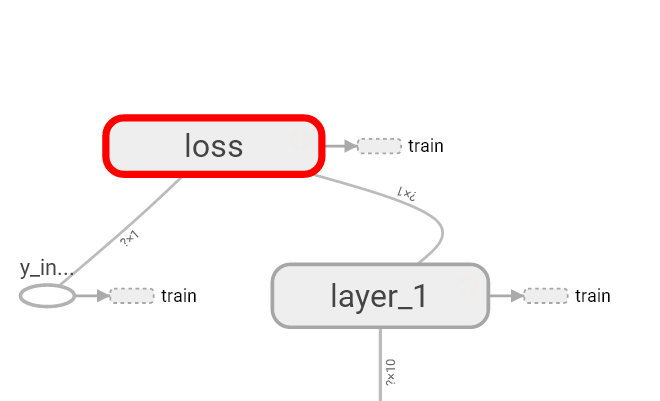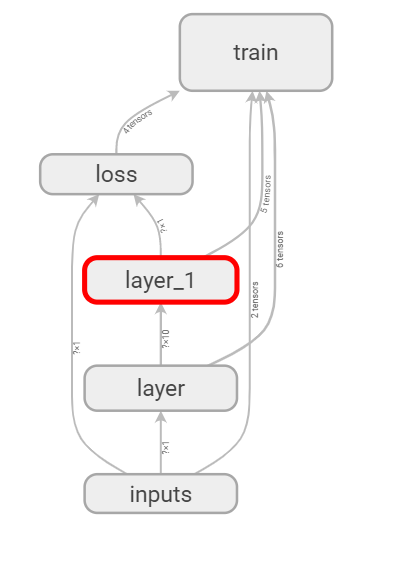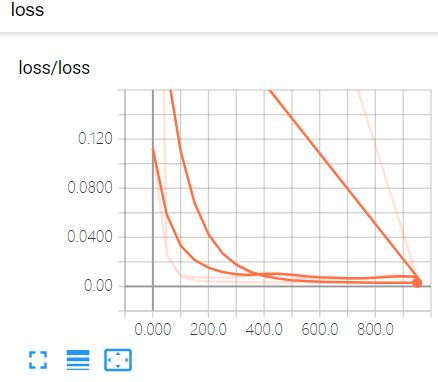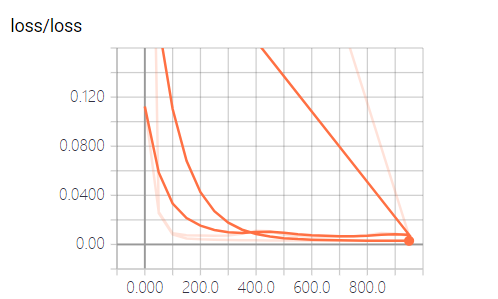TensorFlow实战第四课(tensorboard数据可视化)
tensorboard可视化工具
tensorboard是tensorflow的可视化工具,通过这个工具我们可以很清楚的看到整个神经网络的结构及框架。
通过之前展示的代码,我们进行修改从而展示其神经网络结构。
一、搭建图纸
首先对input进行修改,将xs,ys进行新的名称指定x_in y_in
这里指定的名称,之后会在可视化图层中inputs中显示出来
xs= tf.placeholder(tf.float32, [None, 1],name='x_in')
ys= tf.placeholder(tf.loat32, [None, 1],name='y_in')
使用with.tf.name_scope('inputs')可以将xs ys包含进来,形成一个大的图层,图层的名字就是
with.tf.name_scope()方法中的参数
with tf.name_scope('inputs'):
# define placeholder for inputs to network
xs = tf.placeholder(tf.float32, [None, 1])
ys = tf.placeholder(tf.float32, [None, 1])
接下来编辑layer
编辑前的代码片段:
def add_layer(inputs, in_size, out_size, activation_function=None):
# add one more layer and return the output of this layer
Weights = tf.Variable(tf.random_normal([in_size, out_size]))
biases = tf.Variable(tf.zeros([1, out_size]) + 0.1)
Wx_plus_b = tf.add(tf.matmul(inputs, Weights), biases)
if activation_function is None:
outputs = Wx_plus_b
else:
outputs = activation_function(Wx_plus_b, )
return outputs
编辑后
def add_layer(inputs, in_size, out_size, activation_function=None):
# add one more layer and return the output of this layer
with tf.name_scope('layer'):
Weights= tf.Variable(tf.random_normal([in_size, out_size]))
# and so on...
定义完大的框架layer后,通知需要定义里面小的部件weights biases activationfunction
定义方法有两种,一是用tf.name_scope(),二是在Weights中指定名称W
def add_layer(inputs, in_size, out_size, activation_function=None):
#define layer name
with tf.name_scope('layer'):
#define weights name
with tf.name_scope('weights'):
Weights= tf.Variable(tf.random_normal([in_size, out_size]),name='W')
#and so on......
接着定义biases,方法同上
def add_layer(inputs, in_size, out_size, activation_function=None):
#define layer name
with tf.name_scope('layer'):
#define weights name
with tf.name_scope('weights')
Weights= tf.Variable(tf.random_normal([in_size, out_size]),name='W')
# define biase
with tf.name_scope('Wx_plus_b'):
Wx_plus_b = tf.add(tf.matmul(inputs, Weights), biases)
# and so on....
最后编辑loss 将with.tf.name_scope( )添加在loss上方 并起名为loss
这句话就是绘制了loss

最后再对train_step进行编辑
with tf.name_scope('train'):
train_step = tf.train.GradientDescentOptimizer(0.1).minimize(loss)
我们还需要运用tf.summary.FileWriter( )将上面绘画的图保存到一个目录中,方便用浏览器浏览。
这个方法中的第二个参数需要使用sess.graph。因此我们把这句话放在获取session后面。
这里的graph是将前面定义的框架信息收集起来,然后放在logs/目录下面。
sess = tf.Session() # get session
# tf.train.SummaryWriter soon be deprecated, use following
writer = tf.summary.FileWriter("logs/", sess.graph)
最后在终端中使用命令获取网址即可查看
tensorboard --logdir logs

完整代码:
#如何可视化神经网络 #tensorboard import tensorflow as tf def add_layer(inputs, in_size, out_size, activation_function=None):
# add one more layer and return the output of this layer
with tf.name_scope('layer'):
with tf.name_scope('weights'):
Weights = tf.Variable(tf.random_normal([in_size, out_size]), name='W')
with tf.name_scope('biases'):
biases = tf.Variable(tf.zeros([1, out_size]) + 0.1, name='b')
with tf.name_scope('Wx_plus_b'):
Wx_plus_b = tf.add(tf.matmul(inputs, Weights), biases)
if activation_function is None:
outputs = Wx_plus_b
else:
outputs = activation_function(Wx_plus_b)
return outputs # define placeholder for inputs to network
with tf.name_scope('inputs'):
xs = tf.placeholder(tf.float32, [None, 1], name='x_input')
ys = tf.placeholder(tf.float32, [None, 1], name='y_input') # add hidden layer
l1 = add_layer(xs, 1, 10, activation_function=tf.nn.relu)
# add output layer
prediction = add_layer(l1, 10, 1, activation_function=None) # the error between prediciton and real data
with tf.name_scope('loss'):
loss = tf.reduce_mean(tf.reduce_sum(tf.square(ys - prediction), reduction_indices=[1])) with tf.name_scope('train'):
train_step = tf.train.GradientDescentOptimizer(0.1).minimize(loss) sess = tf.Session() writer = tf.summary.FileWriter("logs/", sess.graph) init = tf.global_variables_initializer() sess.run(init)
-------------------------------------------------------------------
tensorflow可视化训练过程的图标是如何制作的?

首先要添加一些模拟数据。nump可以帮助我们添加一些模拟数据。
利用np.linespace()产生随机的数字 同时为了模拟更加真实 我们会添加一些噪声 这些噪声是通过np.random.normal()随机产生的。
x_data= np.linspace(-1, 1, 300, dtype=np.float32)[:,np.newaxis]
noise= np.random.normal(0, 0.05, x_data.shape).astype(np.float32)
y_data= np.square(x_data) -0.5+ noise
在layer中为weights biases设置变化图表
首先我们在add_layer()方法中添加一个参数n_layer 来标识层数 并且用变量layer_name代表其每层的名称
def add_layer(
inputs ,
in_size,
out_size,
n_layer,
activation_function=None):
## add one more layer and return the output of this layer
layer_name='layer%s'%n_layer ## 定义一个新的变量
## and so on ……
接下来 我们层中的Weights设置变化图 tensorflow中提供了tf.histogram_summary( )方法,用来绘制图片,第一个参数是图表的名称,第二个参数是图标要记录的变量。
def add_layer(inputs ,
in_size,
out_size,n_layer,
activation_function=None):
## add one more layer and return the output of this layer
layer_name='layer%s'%n_layer
with tf.name_scope('layer'):
with tf.name_scope('weights'):
Weights= tf.Variable(tf.random_normal([in_size, out_size]),name='W')
tf.summary.histogram(layer_name + '/weights', Weights)
##and so no ……
同样的方法我们对biases进行绘制图标:
with tf.name_scope('biases'):
biases = tf.Variable(tf.zeros([1,out_size])+0.1, name='b')
tf.summary.histogram(layer_name + '/biases', biases)
至于activation_function( ) 可以不用绘制,我们对output 使用同样的方法
最后通过修改 addlayer()方法如下所示
def add_layer(inputs, in_size, out_size, n_layer, activation_function=None):
# add one more layer and return the output of this layer #对神经层进行命名
layer_name = 'layer%s' % n_layer
with tf.name_scope(layer_name):
with tf.name_scope('weights'):
Weights = tf.Variable(tf.random_normal([in_size, out_size]), name='W')
tf.summary.histogram(layer_name + '/weights', Weights)
with tf.name_scope('biases'):
biases = tf.Variable(tf.zeros([1, out_size]) + 0.1, name='b')
tf.summary.histogram(layer_name + '/biases', biases)
with tf.name_scope('Wx_plus_b'):
Wx_plus_b = tf.add(tf.matmul(inputs, Weights), biases)
if activation_function is None:
outputs = Wx_plus_b
else:
outputs = activation_function(Wx_plus_b, )
tf.summary.histogram(layer_name + '/outputs', outputs)
return outputs
设置loss的变化图
loss是tensorb的event下面的 这是由于我们使用的是tf.scalar_summary()方法。

当你的loss函数图像呈现的是下降的趋势 说明学习是有效的
将所有训练图合并
接下来进行合并打包,tf.merge_all_summaries()方法会对我们所有的summaries合并到一起
sess = tf.Session()
#合并
merged = tf.summary.merge_all() writer = tf.summary.FileWriter("logs/", sess.graph) init = tf.global_variables_initializer()
训练数据
忽略不想写
完整代码如下:(运行代码后需要在终端中执行tensorboard --logdir logs)
import tensorflow as tf
import numpy as np def add_layer(inputs, in_size, out_size, n_layer, activation_function=None):
# add one more layer and return the output of this layer #对神经层进行命名
layer_name = 'layer%s' % n_layer
with tf.name_scope(layer_name):
with tf.name_scope('weights'):
Weights = tf.Variable(tf.random_normal([in_size, out_size]), name='W')
tf.summary.histogram(layer_name + '/weights', Weights)
with tf.name_scope('biases'):
biases = tf.Variable(tf.zeros([1, out_size]) + 0.1, name='b')
tf.summary.histogram(layer_name + '/biases', biases)
with tf.name_scope('Wx_plus_b'):
Wx_plus_b = tf.add(tf.matmul(inputs, Weights), biases)
if activation_function is None:
outputs = Wx_plus_b
else:
outputs = activation_function(Wx_plus_b, )
tf.summary.histogram(layer_name + '/outputs', outputs)
return outputs # Make up some real data
x_data = np.linspace(-1, 1, 300)[:, np.newaxis]
noise = np.random.normal(0, 0.05, x_data.shape)
y_data = np.square(x_data) - 0.5 + noise # define placeholder for inputs to network
with tf.name_scope('inputs'):
xs = tf.placeholder(tf.float32, [None, 1], name='x_input')
ys = tf.placeholder(tf.float32, [None, 1], name='y_input') # add hidden layer
l1 = add_layer(xs, 1, 10, n_layer=1, activation_function=tf.nn.relu)
# add output layer
prediction = add_layer(l1, 10, 1, n_layer=2, activation_function=None) # the error between prediciton and real data
with tf.name_scope('loss'):
loss = tf.reduce_mean(tf.reduce_sum(tf.square(ys - prediction),
reduction_indices=[1]))
tf.summary.scalar('loss', loss) with tf.name_scope('train'):
train_step = tf.train.GradientDescentOptimizer(0.1).minimize(loss) sess = tf.Session()
#合并
merged = tf.summary.merge_all() writer = tf.summary.FileWriter("logs/", sess.graph) init = tf.global_variables_initializer()
sess.run(init) for i in range(1000):
sess.run(train_step, feed_dict={xs: x_data, ys: y_data})
if i % 50 == 0:
result = sess.run(merged,feed_dict={xs: x_data, ys: y_data})
#i 就是记录的步数
writer.add_summary(result, i)
tensorboard查看效果 使用命令tensorboard --logdir logs
TensorFlow实战第四课(tensorboard数据可视化)的更多相关文章
- Tensorflow搭建神经网络及使用Tensorboard进行可视化
创建神经网络模型 1.构建神经网络结构,并进行模型训练 import tensorflow as tfimport numpy as npimport matplotlib.pyplot as plt ...
- TensorFlow实战第三课(可视化、加速神经网络训练)
matplotlib可视化 构件图形 用散点图描述真实数据之间的关系(plt.ion()用于连续显示) # plot the real data fig = plt.figure() ax = fig ...
- TensorFlow实战第七课(dropout解决overfitting)
Dropout 解决 overfitting overfitting也被称为过度学习,过度拟合.他是机器学习中常见的问题. 图中的黑色曲线是正常模型,绿色曲线就是overfitting模型.尽管绿色曲 ...
- TensorFlow实战第八课(卷积神经网络CNN)
首先我们来简单的了解一下什么是卷积神经网路(Convolutional Neural Network) 卷积神经网络是近些年逐步兴起的一种人工神经网络结构, 因为利用卷积神经网络在图像和语音识别方面能 ...
- 吴裕雄 数据挖掘与分析案例实战(5)——python数据可视化
# 饼图的绘制# 导入第三方模块import matplotlibimport matplotlib.pyplot as plt plt.rcParams['font.sans-serif']=['S ...
- CNN中tensorboard数据可视化
1.CNN_my_test.py import tensorflow as tf from tensorflow.examples.tutorials.mnist import input_data ...
- Tensorflow实战第十一课(RNN Regression 回归例子 )
本节我们会使用RNN来进行回归训练(Regression),会继续使用自己创建的sin曲线预测一条cos曲线. 首先我们需要先确定RNN的各种参数: import tensorflow as tf i ...
- Tensorflow实战第十课(RNN MNIST分类)
设置RNN的参数 我们本节采用RNN来进行分类的训练(classifiction).会继续使用手写数据集MNIST. 让RNN从每张图片的第一行像素读到最后一行,然后进行分类判断.接下来我们导入MNI ...
- TensorFlow实战第六课(过拟合)
本节讲的是机器学习中出现的过拟合(overfitting)现象,以及解决过拟合的一些方法. 机器学习模型的自负又表现在哪些方面呢. 这里是一些数据. 如果要你画一条线来描述这些数据, 大多数人都会这么 ...
随机推荐
- 【Winform-自定义控件】DataGridView 单元格合并和二维表头
DataGridView单元格合并和二维表头应用: //DataGridView绑定数据 DataTable dt = new DataTable(); dt.Columns.Add("); ...
- k8s知识1
kubernetes到底有多难?看下面的白话: service 网络通信原理service 由k8s外面的服务作为访问端 内部里面其实是pod————————————————————————————— ...
- 回调函数(callback) python / c++ 演示
什么是回调函数? 我们绕点远路来回答这个问题. 编程分为两类:系统编程(system programming)和应用编程(application programming).所谓系统编程,简单来说,就是 ...
- 伪分布式下Hadoop3.2版本打不开localhost:50070,可以打开localhost:8088
一.问题描述 伪分布式下Hadoop3.2版本打不开localhost:50070,可以打开localhost:8088 二.解决办法 Hadoop3.2版本namenode的默认端口配置已经更改为9 ...
- Solr 5.2.1 部署并索引Mysql数据库
1.Solr简介 Solr是一个高性能,采用Java5开发,SolrSolr基于Lucene的全文搜索服务器.同时对其进行了扩展,提供了比Lucene更为丰富的查询语言,同时实现了可配置.可扩展并对查 ...
- python 异常和弹出框
import tkinter.messagebox try: fileContent = open("abnormal.txt") fileContent.close() prin ...
- HearthBuddy卡组
偶数萨 手打两天已上传说,各位加油 欧洲牧羊人 ### 火元素换艾雅# 职业:萨满祭司# 模式:狂野模式## 2x (2) 图腾魔像 # 2x (2) 大漩涡传送门 # 2x (2 ...
- 静态化-VeloCity
1.在spring.xml中配置 <!-- 指定vm模版路径 start --> <bean id="velocityEngine" class="or ...
- Struts 简单UI标签
<!-- 服务器标签 : 最终别解析为html标签--> <s:form action="/user_login" method="post" ...
- 数据分析 - numpy 模块
numpy 概述 ▨ Numerical Python. 补充了python所欠缺的数值计算能力 ▨ Numpy是其他数据分析及机器学习库的底层库 ▨ Numpy完全标准C语言实现,运行效率充分 ...
